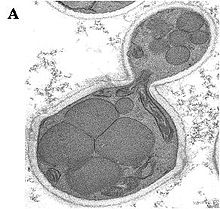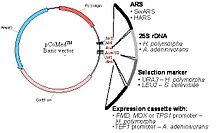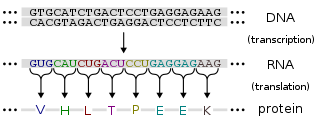
Protein production is the biotechnological process of generating a specific protein. It is typically achieved by the manipulation of gene expression in an organism such that it expresses large amounts of a recombinant gene. This includes the transcription of the recombinant DNA to messenger RNA (mRNA), the translation of mRNA into polypeptide chains, which are ultimately folded into functional proteins and may be targeted to specific subcellular or extracellular locations.
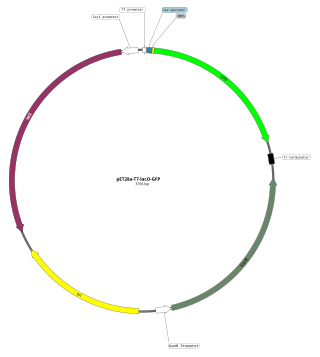
An expression vector, otherwise known as an expression construct, is usually a plasmid or virus designed for gene expression in cells. The vector is used to introduce a specific gene into a target cell, and can commandeer the cell's mechanism for protein synthesis to produce the protein encoded by the gene. Expression vectors are the basic tools in biotechnology for the production of proteins.
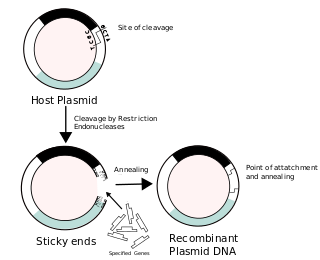
Recombinant DNA (rDNA) molecules are DNA molecules formed by laboratory methods of genetic recombination that bring together genetic material from multiple sources, creating sequences that would not otherwise be found in the genome.
Methylotrophs are a diverse group of microorganisms that can use reduced one-carbon compounds, such as methanol or methane, as the carbon source for their growth; and multi-carbon compounds that contain no carbon-carbon bonds, such as dimethyl ether and dimethylamine. This group of microorganisms also includes those capable of assimilating reduced one-carbon compounds by way of carbon dioxide using the ribulose bisphosphate pathway. These organisms should not be confused with methanogens which on the contrary produce methane as a by-product from various one-carbon compounds such as carbon dioxide. Some methylotrophs can degrade the greenhouse gas methane, and in this case they are called methanotrophs. The abundance, purity, and low price of methanol compared to commonly used sugars make methylotrophs competent organisms for production of amino acids, vitamins, recombinant proteins, single-cell proteins, co-enzymes and cytochromes.

Komagataella is a methylotrophic yeast within the order Saccharomycetales. It was found in the 1960s as Pichia pastoris, with its feature of using methanol as a source of carbon and energy. In 1995, P. pastoris was reassigned into the sole representative of genus Komagataella, becoming Komagataella pastoris. Later studies have further distinguished new species in this genus, resulting in a total of 7 recognized species. It is not uncommon to see the old name still in use in the contect of protein production, as of 2023; in less formal use, the yeast may confusingly be referred to as pichia.

Pichia is a genus of yeasts in the family Pichiaceae with spherical, elliptical, or oblong acuminate cells. Pichia is a teleomorph, and forms hat-shaped, hemispherical, or round ascospores during sexual reproduction. The anamorphs of some Pichia species are Candida species. The asexual reproduction is by multilateral budding.

Batroxobin, also known as reptilase, is a snake venom enzyme with Venombin A activity produced by Bothrops atrox and Bothrops moojeni, venomous species of pit viper found east of the Andes in South America. It is a hemotoxin which acts as a serine protease similarly to thrombin, and has been the subject of many medical studies as a replacement of thrombin. Different enzymes, isolated from different species of Bothrops, have been called batroxobin, but unless stated otherwise, this article covers the batroxobin produced by B. moojeni, as this is the most studied variety.
Cell wall protein 2 (CWP2) is a cell wall protein, produced by Saccharomyces cerevisiae and Saccharomyces pastorianus. It occurs throughout the cell wall and has close homology with the CWP1 gene.
Arxula adeninivorans is a dimorphic yeast with unusual characteristics. The first description of A. adeninivorans was provided in the mid-eighties. The species was initially designated as Trichosporon adeninovorans. After the first identification in the Netherlands, strains of this species were later on also found in Siberia and in South Africa in soil and in wood hydrolysates. Recently, A. adeninivorans was renamed as Blastobotrys adeninivorans after a detailed phylogenetic comparison with other related yeast species. However, many scientists desire to maintain the popular name A. adeninivorans.
A yeast expression platform is a strain of yeast used to produce large amounts of proteins, sugars or other compounds for research or industrial uses. While yeast are often more resource-intensive to maintain than bacteria, certain products can only be produced by eukaryotic cells like yeast, necessitating use of a yeast expression platform. Yeasts differ in productivity and with respect to their capabilities to secrete, process and modify proteins. As such, different types of yeast are better suited for different research and industrial applications.

D-Xylose is a five-carbon aldose that can be catabolized or metabolized into useful products by a variety of organisms.
A subunit vaccine is a vaccine that contains purified parts of the pathogen that are antigenic, or necessary to elicit a protective immune response. Subunit vaccine can be made from dissembled viral particles in cell culture or recombinant DNA expression, in which case it is a recombinant subunit vaccine.
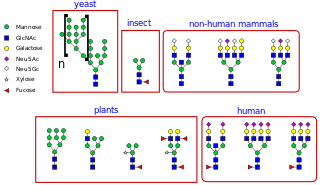
N-linked glycosylation, is the attachment of an oligosaccharide, a carbohydrate consisting of several sugar molecules, sometimes also referred to as glycan, to a nitrogen atom, in a process called N-glycosylation, studied in biochemistry. The resulting protein is called an N-linked glycan, or simply an N-glycan.
Scheffersomyces stipitis is a species of yeast, belonging to the "CUG Clade" of ascomycetous yeasts. This is a group of fungi that substitute serine for leucine when the CUG codon is encountered. S. stipitis is distantly related to brewer's yeast, Saccharomyces cerevisiae, which uses the conventional codon system. Found, among other places, in the guts of passalid beetles, S. stipitis is capable of both aerobic and oxygen limited fermentation, and has the highest known natural ability of any yeast to directly ferment xylose, converting it to ethanol, a potentially economically valuable trait. Xylose is a hemicellulosic sugar found in all angiosperm plants. As such xylose constitutes the second most abundant carbohydrate moiety in nature. Xylose can be produced from wood or agricultural residues through auto- or acid hydrolysis. Ethanol production from such lignocellulosic residues does not compete with food production through the consumption of grain.
Heterologous expression refers to the expression of a gene or part of a gene in a host organism that does not naturally have the gene or gene fragment in question. Insertion of the gene in the heterologous host is performed by recombinant DNA technology. The purpose of heterologous expression is often to determine the effects of mutations and differential interactions on protein function. It provides an easy path to efficiently express and experiment with combinations of genes and mutants that do not naturally occur.
Gcn4 is a transcription factor and a “master regulator” for gene expression which regulates close to one tenth of the yeast genome. In a study by Razaghi et al, amino acid starvation activated the transcription factor Gcn4p, resulting in transcriptional induction of almost all genes involved in amino acid biosynthesis, including HIS4. Thus involvement of Gcn4 in regulation of both histidinol dehydrogenase HIS4 and interferon gamma hIFNγ was hypothesised as a scenario explaining the increased level of hIFNγ under amino acid starvation.
Aerobic fermentation or aerobic glycolysis is a metabolic process by which cells metabolize sugars via fermentation in the presence of oxygen and occurs through the repression of normal respiratory metabolism. Preference of aerobic fermentation over aerobic respiration is referred to as the Crabtree effect in yeast, and is part of the Warburg effect in tumor cells. While aerobic fermentation does not produce adenosine triphosphate (ATP) in high yield, it allows proliferating cells to convert nutrients such as glucose and glutamine more efficiently into biomass by avoiding unnecessary catabolic oxidation of such nutrients into carbon dioxide, preserving carbon-carbon bonds and promoting anabolism.
Pundi Narasimhan Rangarajan is an Indian biochemist, virologist and a professor at the department of biochemistry of the Indian Institute of Science. Prof Rangarajan is currently the Chairman of the Department of Biochemistry at Indian Institute of Science. Known for his research on eukaryotic gene expression, Rangarajan is an elected fellow of all the three major Indian science academies viz. National Academy of Sciences, India, Indian Academy of Sciences and Indian National Science Academy. The Council of Scientific and Industrial Research, the apex agency of the Government of India for scientific research, awarded him the Shanti Swarup Bhatnagar Prize for Science and Technology, one of the highest Indian science awards for his contributions to Medical Sciences in 2007.
Bacillus methanolicus is a gram positive, thermophilic, methylotrophic member of the genus Bacillus. The most well characterized strain of the species, Bacillus methanolicus MGA3, was isolated from freshwater marsh soils, and grows rapidly in cultures heated to up to 60 °C using only methanol as a carbon source. The genome of B. methanolicus MGA3 was fully sequenced in 2014, revealing a 3,337,035 bp linear chromosome and two natural plasmids, pBM19 and pBM69.

Ogataea is a genus of ascomycetous yeasts in the family Saccharomycetaceae. It was separated from the former genus Hansenula via an examination of their 18S and 26S rRNA partial base sequencings by Yamada et al. 1994.
